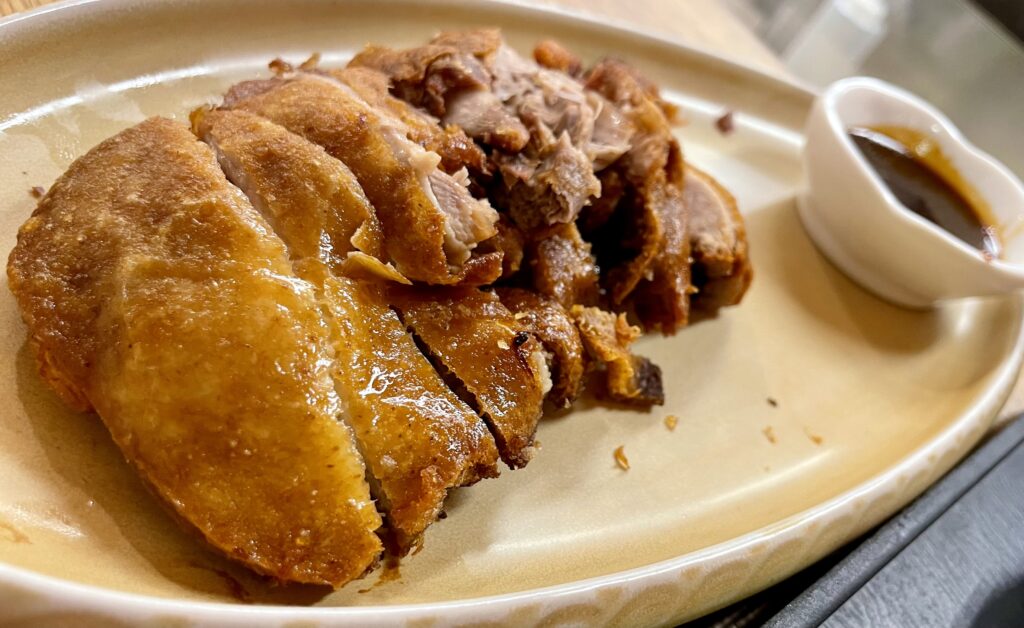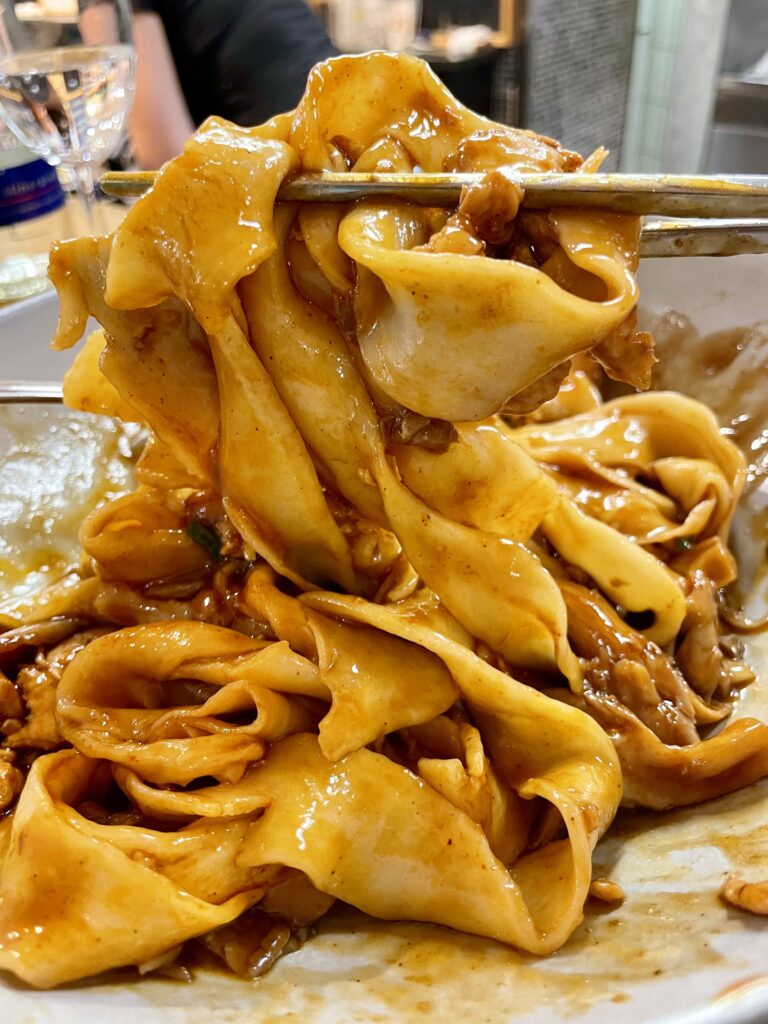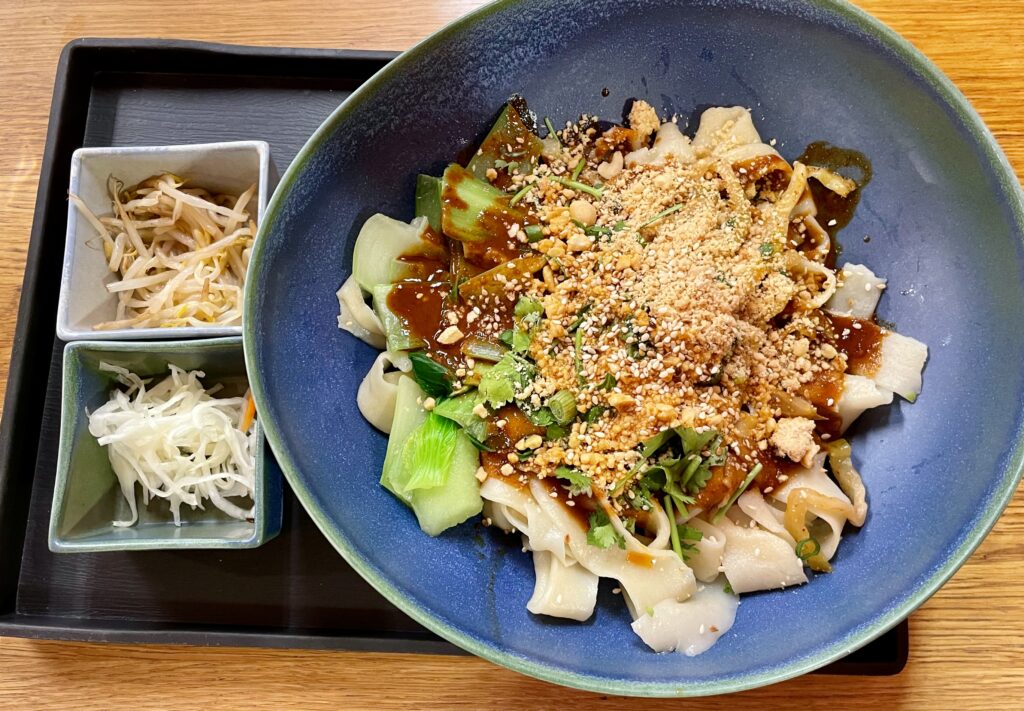A few weeks ago we introduced you to one trendiest noodle spots in Munich: Max’s Beef Noodles at Sendlinger Tor. If you liked it, you’re in for another treat. Today we’d like to introduce you to another destination for authentic Chinese noodle dishes: Chen’s Noodle Bar.
Conveniently located in the heart of Munich at Marienplatz, Chen’s Noodle Bar is the perfect place to refuel after a day of shopping. You’ll find it in the delicatessen department on the first basement level of Galeria Kaufhof/Karstadt. Don’t be fooled by its discreet corner location – this hidden gem serves up some truly authentic flavours. If you need help finding it, just ask the staff for directions.
Restaurant Profile
- Name of the Restaurant: Chen’s Nudelbar (view menu here)
- Adress: 1. UG Galeria Kaufhof Marienplatz, Kaufingerstraße 1, 80331 München
- Style: Chinese Cuisine – Noodles, Dumplings, Rice Bowls
- Price: around 15 – 25 EUR per Person (incl. drinks and tips)
At Chen’s Noodle Bar, everything revolves around the art of delicious noodle dishes: from fragrant noodle soups known as tāngmiàn (汤面) to bold and spicy dry noodle dishes called bànmiàn (拌面). The menu also includes the popular handmade Chinese dumplings or jiaozi (手工水饺 – Shǒugōng Shuǐjiǎo) and traditional wonton soup (馄饨汤 – Húntun Tāng). To complete the experience, guests can choose from a tempting selection of hot and cold side dishes.
For those not in the mood for noodles, Chen’s also serves classic rice dishes such as Peking duck and sweet and sour chicken. But if you’re here for the first time, one of the signature noodle dishes is a must!
According to the restaurant’s website, Chen’s Noodle Bar frequently introduces new specialities, so the menu may vary each time you visit. Who knows? Next time you visit, you might discover a whole new range of delicious dishes!
At Chen’s Noodle Bar, as at Max’s Beef Noodles, the noodles – known as lamian (from the Chinese words “la” (拉) for “pull” and “mian” (面) for “noodles”) – are traditionally hand-pulled, giving guests the unique experience of watching this impressive technique at close quarters. We were lucky enough to be seated at the bar, where we could watch the chefs prepare the noodles right in front of us. The bar area is small but very popular, so it tends to be busy. To avoid waiting, it’s best to go outside peak times, but you should generally be able to get a seat at any time.
Let’s take a look at the dishes we ordered during our visit, starting with the starters: we chose fried bush beans and Peking duck.
Fried beans (Gān Shāo Biǎndòu – 干烧扁豆) are a speciality of Chinese cuisine, particularly from Sichuan. Made from flat green beans, they’re prepared in the “dry fried” style, which means they’re cooked without any liquid such as broth or soup. The beans are stir-fried over high heat, giving them a smoky, slightly crunchy texture. Flavours such as garlic and ginger are used to enhance their savoury profile.

Soy sauce is then added to give the dish a rich umami depth. Finally, the beans are topped with sesame seeds, which introduce a subtle sweet and nutty flavour that complements the umami of the beans beautifully.
Beijing duck (Cuì Pí Kǎoyā – 脆皮烤鸭) is a variation of the famous Chinese Peking duck. The name translates as “crispy skin” (cuì pí) and “roasted duck” (kǎo yā), highlighting its signature feature: the wonderfully crispy skin.

Traditional Peking duck is prepared with great care: it’s air-dried and roasted in special ovens at high temperatures to achieve a thin, delicate skin and tender meat. In contrast, Cuì Pí Kǎoyā emphasizes achieving an exceptionally crispy skin. Unlike Peking duck, this version is served without elaborate presentation, making it a more straightforward yet equally satisfying dish.
The duck is first marinated in a special blend of spices and glazed with sugar or syrup if necessary. It’s then basted in hot oil and slowly roasted in the oven, a process that creates the characteristic crispy, lightly caramelized skin while keeping the meat juicy and tender. This combination of crisp texture, aromatic spices, and tender meat results in a rich, slightly sweet umami flavor.
Unlike traditional Peking duck, this version is served without the usual pancake (jiānbǐng – 煎饼) and vegetables – the focus is on the duck itself. However, it’s accompanied by tianmiàn jiàng (甜面酱), a condiment made from fermented wheat flour, similar to the one used in classic Peking duck. The paste, which contains wheat flour, salt, water, a pinch of sugar, and sometimes soy sauce, becomes dark, thick, and intensely flavorful with a slight sweet-salty undertone – an ideal complement to the crispy, juicy duck.
Moving on to the main courses, we focused on the heart of the menu: the noodle dishes. We opted for the handmade Lamian noodles with minced chicken and mushrooms, and the spicy Szechuan Lamian.
The minced chicken and (king) oyster mushroom Lamian (Jīróng Xìngbàogū or Pínggū Lāmiàn – 鸡蓉杏鲍菇(或平菇)拉面 are served in a savory chicken and mushroom sauce. The dish contains small pieces of chicken or minced chicken (鸡蓉 – jī róng) and optionally king oyster mushrooms (杏鲍菇, xìng bào gū) or oyster mushrooms (平菇, píng gū).

The chicken and mushrooms create a rich umami base, while the mushrooms’ delicate, slightly nutty flavor and meaty texture add depth to the dish. Soy sauce, scallions, and other spices contribute to the complexity of the flavor profile.
Made from wheat flour, water, and salt, Lamian noodles are created through the labor-intensive process of hand-pulling and folding the dough, giving them a soft yet resilient texture. These noodles absorb the flavors of the sauce beautifully, and their tender yet firm consistency provides a satisfying mouthfeel.
The dish is garnished with onions, which add a sweet and savory note, and fresh, crisp scallions for a burst of freshness.

Sichuan Lamian (Chóngqìng Xiǎo Bànmiàn – 重庆小拌面) originates from the vibrant city of Chongqing in Sichuan Province, one of China’s most famous culinary regions. Known for its bold and varied flavors, Chongqing cuisine is particularly famous for its fiery heat, which comes from the liberal use of chili and Sichuan pepper (huajiao – 花椒).

This vegetarian version of lamian noodles is packed with fresh ingredients and aromatic spices. At Chen’s Noodle Bar, the dish features an assortment of fresh vegetables and spices, including Szechuan zhacai (榨菜), scallions, cilantro, peanuts, and a spicy sauce of ginger, garlic, chili, and sesame that gives the dish its signature spicy kick.
Zhacai, or pickled mustard greens, are known for their salty, slightly sour flavor and chewy texture, which complement the lamian noodles. The dish also includes pak choi, which offers a sweet, mild flavor and a crisp, refreshing contrast to the sharp, spicy notes of the Szechuan sauce. Pak choi’s tender leaves and crisp stems not only add texture, but also provide a nutritional boost, as it is rich in vitamins C and K and essential minerals.

Finally, the dish is topped with a garnish of fresh scallions, cilantro and roasted peanuts. The scallions provide a mild onion flavor, the cilantro brings a bright, aromatic note, and the peanuts add a satisfying crunch and nutty depth to complete the dish.
Conclusion: Chen’s Noodle Bar at Marienplatz is a true haven for noodle lovers in Munich. Here you can enjoy hand-pulled Lamian noodles in a variety of delicious styles, all made fresh and authentically. Whether you’re enjoying a fragrant noodle soup or a hearty bowl of spicy bànmiàn, each dish is a masterpiece in its own right!





